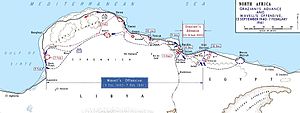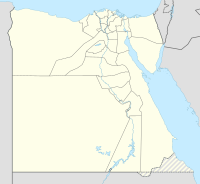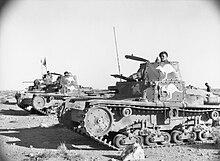| Attack on Nibeiwa | |||||||
|---|---|---|---|---|---|---|---|
| Part of Operation Compass, during the Second World War | |||||||
 Map of the Italian invasion of Egypt | |||||||
| |||||||
| Belligerents | |||||||
| Commanders and leaders | |||||||
| Pietro Maletti † | |||||||
| Units involved | |||||||
| Maletti Group | |||||||
| Strength | |||||||
| 5,000 soldiers 47 tanks | 4,100 soldiers 23 tanks | ||||||
| Casualties and losses | |||||||
| 56 killed 27 tanks disabled/broken down | 819 killed 1,338 wounded 2,000 prisoners 28 tanks | ||||||
Nibeiwa, 12 mi (19 km) south of the port of Sidi Barrani | |||||||
The Attack on Nibeiwa took place on 9 December 1940 near Nibeiwa, Egypt, when the Italian fortified camp held by the Maletti Group, the armoured force of the 10th Army, was overrun by British and Indian troops. The attack was the opening engagement of Operation Compass, a British raid which, if successful, would be followed up to try to expel the Italians from Egypt. Italy had declared war on France and Britain on 10 June and in the Italian invasion of Egypt (Operazione E) from 9 to 16 September 1940, the Italian 10th Army had reached the port of Sidi Barrani and dug in to await the completion of the Via della Vittoria , an extension of the Via Balbia , being built from the frontier. The Maletti Group garrisoned a camp at Nibeiwa,12 mi (19 km) south of the port of Sidi Barrani.
Contents
- Background
- Italian invasion of Egypt
- Western Desert Force
- Maletti Group
- Prelude
- Nibeiwa
- British plan
- Battle
- Aftermath
- Analysis
- Casualties
- Subsequent operations
- See also
- References
- Bibliography
The British had fought a delaying action during the Italian advance with the 7th Support Group of the 7th Armoured Division and kept their main force at the railhead of Mersa Matruh about 80 mi (130 km) east of Sidi Barrani. The British probed the Italian defences continually and then planned a five-day raid on Italian fortified camps, which had been built in an arc from the coast at Maktila to Sofafi in the south-west on the inland escarpment. The British intended to advance into the Nibeiwa–Rabia gap and attack Nibeiwa from the west. If the attack succeeded, the British would move on to attack the camps at Tummar West and Tummar East. The tanks of the 7th Armoured Division would form a defensive screen to the west, to protect the flank of the 4th Indian Infantry Division as it attacked the camps and be ready to intercept an Italian counter-attack.
The British and Indian infantry rehearsed an attack with the infantry tanks of the 7th Royal Tank Regiment in late November and another rehearsal was announced for early December, which was actually the attack. On the night of 9/10 December the attack began with diversions on the east side as the main force closed up from the west. The real attack took the Italians by surprise, destroyed the 28 tanks before their crews could react and then broke into the camp. The Italian and Libyan garrison resisted the attack with great determination but were systematically overrun by a combination of tanks, artillery firing from point-blank range and infantry. The Italian and Libyan troops suffered 4,157 casualties for a British loss of 56 men killed and 27 tanks disabled or broken down. The success at Nibeiwa began the collapse of the Italian position in Egypt.




